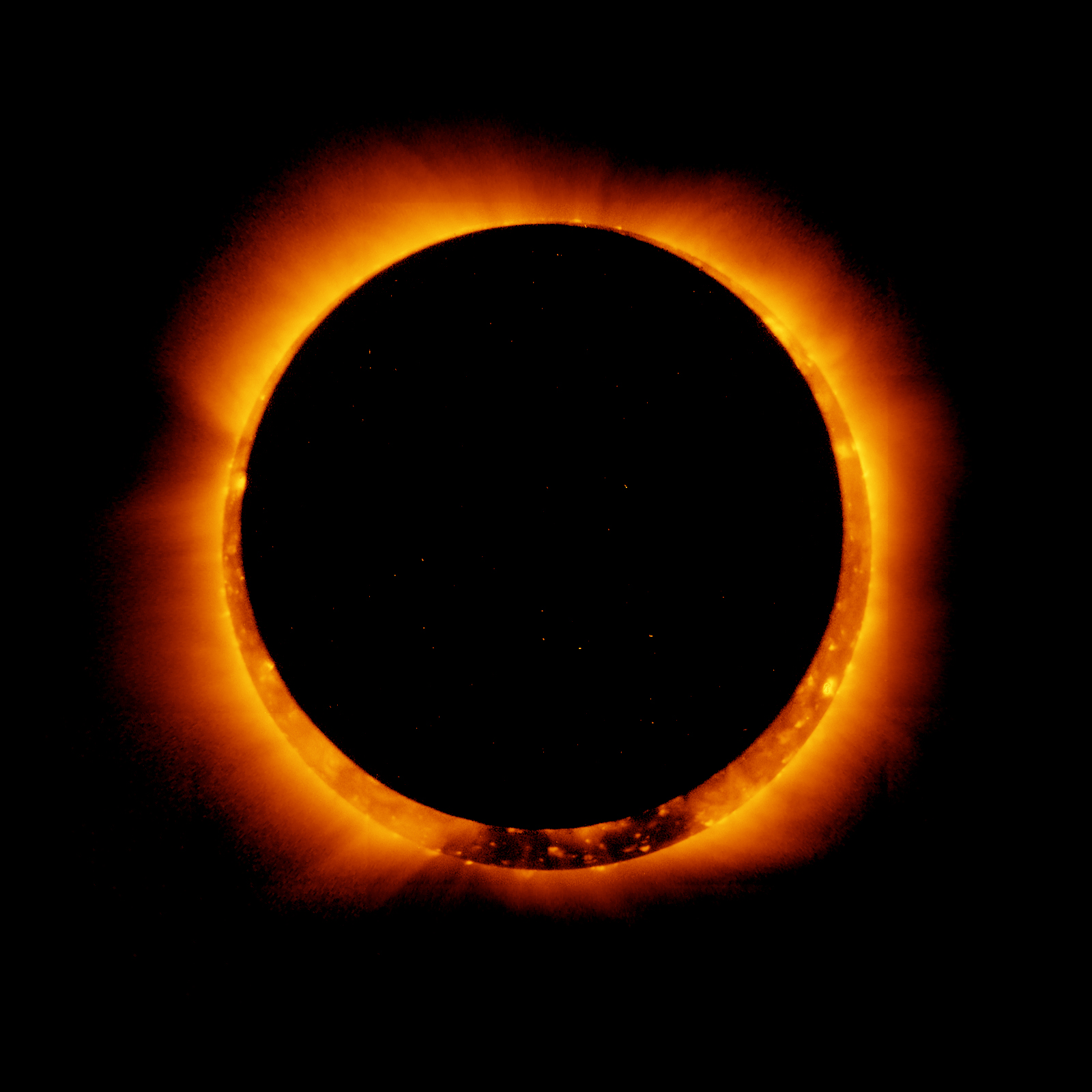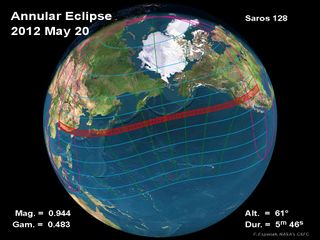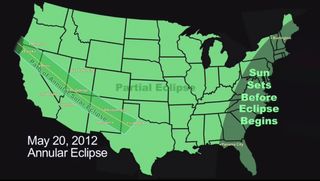Rare 'Ring of Fire' Solar Eclipse Visible from China to Texas Today

Skywatchers from China to Texas are in for a rare celestial treat today when the moon blots out most of the sun to create dazzling "ring of fire" solar eclipse.
The eclipse today (May 20) is known as an annular solar eclipse and is the first of its kind to be widely visible from much of the United States since 1994. Annular eclipses only occur when the moon is at a point in its orbit that is too far from Earth to completely block the sun's disk. The result is a ring-like, or annulus, effect that will be visible to observers lucky enough to be in the path of the eclipse's shadow.
"This is going to be a great photo opportunity," said Robert Naeye, editor in chief of Sky & Telescope magazine, in a statement.
During today's solar eclipse, the moon will block up to 94 percent of the sun's disc and last about 4 1/2 minutes for skywatchers inside a 186-mile-wide (300-kilometer) track that begins at 6:36 p.m. EDT (2236 GMT) in southern China (where the local time will be May 21), crosses the northern Pacific Ocean, then makes landfall in northern California. [Annular Solar Eclipse of May 20 (A Photo Guide)]
The eclipse's track will cross eight western U.S. states before it ends at sunset in northwestern Texas. While the "ring of fire" effect is only visible from the eclipse's primary track, wide regions around the eclipse path will get partial solar eclipse views, according to NASA eclipse expert Fred Espenak. The parts of the United States to miss the partial eclipse views are on the East Coast, he explained in NASA eclipse guide.

From start to finish, the annular solar eclipse — the first solar eclipse of 2012 — will last about 3 1/2 hours and cross about 8,450 miles (13,600 km) as it moves across the Earth.
"It certainly will not become as dark as night; instead you might call it a weird 'counterfeit twilight' as the quality of the light, may become unearthly," SPACE.com skywatching columnist Joe Rao explains in a viewing guide. "A clear sky should turn deep blue and the landscape oddly silvery. The temperature may take a perceptible drop; a cool breeze may begin to blow."
Get the Space.com Newsletter
Breaking space news, the latest updates on rocket launches, skywatching events and more!
And the sun and moon aren't the only objects to see in the sky during the eclipse.
"Look for Venus — it's shining east of the sun by about two fist-widths at arm's length," advises Alan MacRobert, a senior editor with Sky & Telescope magazine. "Jupiter and Mercury will be tougher. They're on the other side of the sun by about a quarter and a third as far, respectively, and they're not as bright."

Eclipse chasers around the world
Today's solar eclipse has drawn out intense interest from veteran astronomers and amateur skywatchers around the world.
Supplies of solar eclipse glasses reportedly ran low in many locations directly in the path of the eclipse and one venue – the University of Colorado at Boulder — is expecting a crowd of at least 13,000 people to fill to Folsom Field (a football stadium) for a free day of eclipse observing in what university official have billed the world's largest solar eclipse viewing party.
Astronauts may even see the solar eclipse from space, NASA officials said. The six-crew of the International Space Station may get a chance to observe the moon's shadow on Earth cast by the eclipse, they added.
Many organizations plan to offer live broadcasts of the solar eclipse. In Japan, for example, the electronics company Panasonic is staging an expedition to webcast the solar eclipse from the top of Mt. Fuji. [Webcast Info: How to Watch the Solar Eclipse Online]
In the United States, several groups have mounted expeditions to observe the solar eclipse from picturesque viewing spots.
Scientists at NASA's Lunar Science Institute at the Ames Research Center in Moffett Field, Calif., have ventured to Grand Canyon National Park in Arizona to witness the eclipse and offer free information sessions to park visitors. Well before today's event, the U.S. National Park Service issued a national invitation to the public to watch the solar eclipse from a national park.
Today, the National Park Service will gather astronomers and park rangers at Petroglyph National Monument in Albuquerque, N.M., from 5 p.m. to 8:30 p.m. MDT to discuss the solar eclipse.
For a list of solar eclipse viewing times for 52 cities in the United States, see this NASA chart Espenak.
For a list of solar eclipse viewing times in Canada, Mexico and Asia, Espenak has prepared this handy chart.
Solar eclipse safety
One important thing to keep in mind when planning to observe today's solar eclipse is eye safety. The sun can cause serious eye damage if observed by the unaided eye or through an unfiltered telescope.
NEVER observe the sun directly of with telescopes or binoculars without using proper solar filters. Regular sunglasses do NOT provide adequate protection for solar eclipse observing.
Seasoned skywatchers use solar filters for telescopes or binoculars to safely view the sun. Special eclipse glasses or welder's glass No. 14 can also serve as a proper filter.
A simple way to observe the sun is to create a pinhole projector, or a pinhole camera. The most simple version can be created by punching a tiny hole in a piece of paper holding it between the sun and another shaded piece of paper. Light from a telescope or binoculars can also be projected onto a separate paper viewing.
You can also build a pinhole project from a shoebox. Staff writer Natalie Wolchover of SPACE.com's sister site Life's Little Mysteries gives you complete, easy-to-follow pinhole camera instructions in this video.
SPACE.com will be providing team coverage of today's solar eclipse:
- In San Francisco, SPACE.com senior writer Mike Wall will monitor the solar eclipse from the city's Exploratorium science center.
- In Boulder, Colo., Livescience senior writer Stephanie Pappas will cover the University of Colorado's giant solar eclipse viewing party at Folsom Field.
- In Arizona, SPACE.com contributors Imelda Joson and Edwin Aguirre — veteran eclipse chasers and space photographers— are seeking out a choice observing spot of the eclipse at Horseshoe Bend near Page, Ariz.
Visit SPACE.com tonight for more updates, photos and reports of May 20, 2012 annular solar eclipse.
Editor's note: If you snap a great photo of Sunday's annular solar eclipse and would like it to be considered for use in a story or gallery, please send images and comments to SPACE.com managing editor Tariq Malik at tmalik@space.com.
You can follow SPACE.com Managing Editor Tariq Malik on Twitter @tariqjmalik. Follow SPACE.com for the latest in space science and exploration news on Twitter @Spacedotcom and on Facebook.
Join our Space Forums to keep talking space on the latest missions, night sky and more! And if you have a news tip, correction or comment, let us know at: community@space.com.

Tariq is the Editor-in-Chief of Space.com and joined the team in 2001, first as an intern and staff writer, and later as an editor. He covers human spaceflight, exploration and space science, as well as skywatching and entertainment. He became Space.com's Managing Editor in 2009 and Editor-in-Chief in 2019. Before joining Space.com, Tariq was a staff reporter for The Los Angeles Times covering education and city beats in La Habra, Fullerton and Huntington Beach. In October 2022, Tariq received the Harry Kolcum Award for excellence in space reporting from the National Space Club Florida Committee. He is also an Eagle Scout (yes, he has the Space Exploration merit badge) and went to Space Camp four times as a kid and a fifth time as an adult. He has journalism degrees from the University of Southern California and New York University. You can find Tariq at Space.com and as the co-host to the This Week In Space podcast with space historian Rod Pyle on the TWiT network. To see his latest project, you can follow Tariq on Twitter @tariqjmalik.